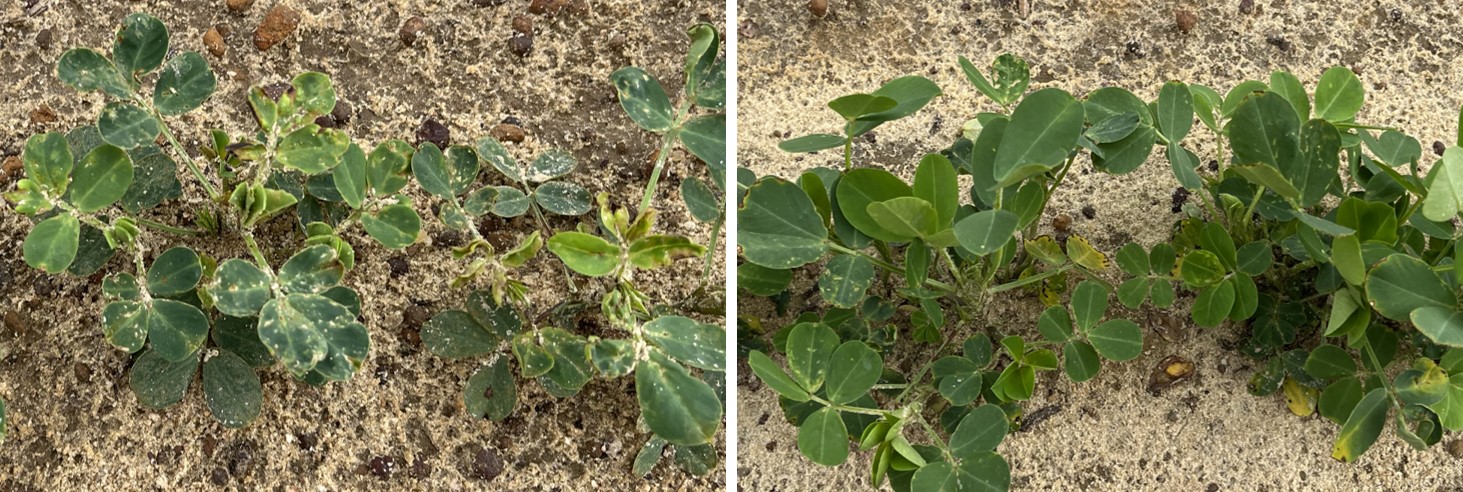Uncategorized
-
We are at the point in the growing season where a lot of Georgia peanut fields are 25 to 35 days after planting. Though thrips pressure has not been particularly high in 2023, it doesn’t take many adults per plant to produce a damaging population of immatures on peanut. Thrips injury typically peaks around 28…
Posted in: Uncategorized -
Peanut planting time has arrived in Georgia, and that means thrips season is here as well. Many of the decisions a peanut grower makes at planting will affect the risk of thrips infestation and the risk of Tomato spotted wilt disease. By now, growers should have a plan for managing thrips and TSWV, but here…
Posted in: Uncategorized -

The value of at-plant insecticides for thrips management was readily apparent in UGA trials this week in Tifton. While untreated peanuts were getting hammered (picture on the left below), all of the in-furrow insecticide treatments we are evaluating were holding up pretty good (picture on the right below: phorate treated). Thrips injury generally peaks around…
Posted in: Uncategorized -
The following is an except from a news release from EPA on 18 August 2021. The revocation of the tolerances for all commodities will be effective 6 months after the publication of the final rule in the Federal Register. “WASHINGTON – The U.S. Environmental Protection Agency (EPA) announced it will stop the use of the…
Posted in: Uncategorized -
There are two species of rootworm in Georgia peanut fields, the southern corn rootworm and the banded cucumber beetle. The immature or larval stage of both species feed on developing peanut pods and require moist soil conditions for survival. Rootworm infestations are typically found in fields with center pivot irrigation and heavier soil texture. With…
Posted in: Uncategorized -
Continued rainfall in Georgia is mostly good news for peanut growers from an insect management point of view (disease management is a different story, but Dr. Kemerait can tell that one). The most damaging pest of peanut in Georgia is the lesser cornstalk borer (LCB), and while it does not disappear when rainfall is plentiful,…
Posted in: Uncategorized -
Georgia peanut growers need to scout their fields this week for tobacco budworm. Infestations of this pest have been on the rise in peanut over the last fourteen days, and it does not take a lot of budworm caterpillars to cause significant defoliation when the crop is less than 50 days after emergence. We do…
Posted in: Uncategorized -
If you have been walking or riding through peanut fields in Georgia over the past week you have almost certainly noticed fields with thrips injury, or as some of my colleagues say, “thrippy peanuts”. Thrips injury varies in severity from minor feeding scars on fully expanded leaflets to severely deformed or dead terminal buds. Peanuts…
Posted in: Uncategorized -
The 2021 UGA Cotton-Peanut-Soybean Insect Scout School will be held on Monday, June 7 at the UGA Tifton Campus Conference Center in Tifton, GA. The scout school will also be held in East Georgia on June 15 at the Southeast Research and Education Center in Midville, GA. Scout school will begin at 9:00 AM and…
Posted in: Uncategorized -
Several folks have contacted me this week about large numbers of white-lined (aka white-margined) burrower bugs. Most of the bugs have been on volunteer peanuts, but some were on cotton seedlings. This insect is not the “peanut burrower bug” and is not considered a pest of peanut. While it can be very abundant early in…
Posted in: Uncategorized